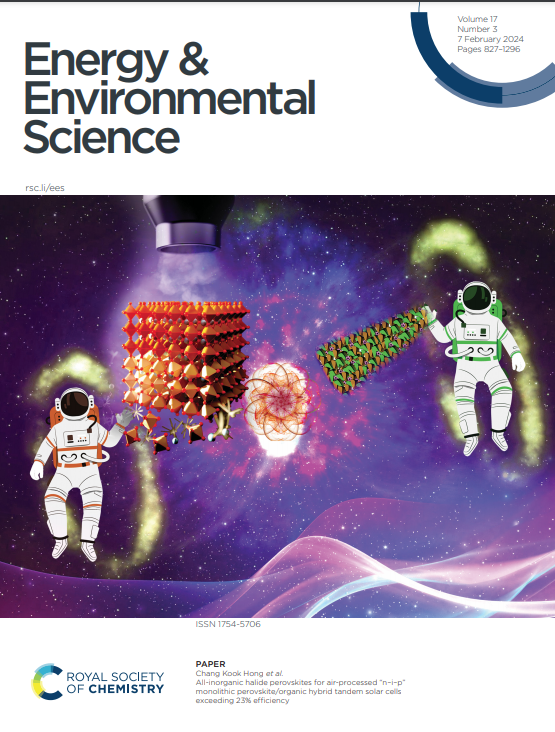竞争协调效应在-40°C下同时实现锂金属袋电池的高能量和稳定循环
IF 30.8
1区 材料科学
Q1 CHEMISTRY, MULTIDISCIPLINARY
引用次数: 0
摘要
锂金属电池(lmb)在极低温条件下(即- 40°C)有望具有显著的优势,这主要是由于锂金属阳极的离子传输途径和沉积/剥离机制非常短。然而,由于在极低温度下的恶劣条件,能够在- 40°C下稳定工作的高能量密度锂金属袋状电池很少被报道。本文设计了一种适用于- 40°C使用的锂金属袋电池,并与新开发的电解质相结合,同时实现了高能量和稳定的循环性能。lmb的低温性能是由第一溶剂鞘层中的竞争配位效应激活的。Li+与碳酸二甲酯(DMC)和1,2 -二甲氧基乙烷(DME)之间的竞争配位削弱了Li+与溶剂之间的相互作用,扩大了电压窗口,有利于在低温条件下形成坚固的富无机界面。值得注意的是,设计并组装了能量为300 Wh kg−1的低温锂金属袋电池。当在- 40°C的极低温度下测试时,锂金属袋电池可以保留77%的能量输出,70次循环后容量保持93%。这项工作为具有竞争能量密度和稳定循环寿命的低温lmb铺平了道路。本文章由计算机程序翻译,如有差异,请以英文原文为准。
Competitive Coordination Effect to Simultaneously Achieve High-Energy and Stable Cycles in Li-Metal Pouch Cell under –40°C
Lithium metal batteries (LMBs) are expected to have significant advantages under extreme low-temperature conditions (i.e., −40°C), mainly due to the much short ion transport pathway and deposition/stripping mechanism of Li metal anode. However, high-energy-density Li-metal pouch cells capable of stable operation at −40°C have rarely been reported due to the harsh condition under extremely low-temperature. Herein, a Li-metal pouch cell suitable for use at −40°C was designed, and coupled with a newly developed electrolyte, to simultaneously achieve high energy and stable cycling performance. The low-temperature capability of the LMBs is activated by a competitive coordination effect in the first solvation sheaths. The competitive coordination between Li+ and dimethyl carbonate (DMC) and 1, 2-dimethoxyethane (DME) weakens the interaction between Li+ and the solvent, widens the voltage window, and facilitates the formation of robust inorganic-rich interfaces under low-temperature conditions. Notably, a low-temperature Li-metal pouch cell was designed and assembled with an energy at 300 Wh kg−1. When tested at the extremely low temperature of −40°C, the Li-metal pouch cell can retain 77% of its energy output, with 93% capacity retention after 70 cycles. This work paves the way for low-temperature LMBs with competitive energy density and stable cycle life.
求助全文
通过发布文献求助,成功后即可免费获取论文全文。
去求助
来源期刊

Energy & Environmental Science
化学-工程:化工
CiteScore
50.50
自引率
2.20%
发文量
349
审稿时长
2.2 months
期刊介绍:
Energy & Environmental Science, a peer-reviewed scientific journal, publishes original research and review articles covering interdisciplinary topics in the (bio)chemical and (bio)physical sciences, as well as chemical engineering disciplines. Published monthly by the Royal Society of Chemistry (RSC), a not-for-profit publisher, Energy & Environmental Science is recognized as a leading journal. It boasts an impressive impact factor of 8.500 as of 2009, ranking 8th among 140 journals in the category "Chemistry, Multidisciplinary," second among 71 journals in "Energy & Fuels," second among 128 journals in "Engineering, Chemical," and first among 181 scientific journals in "Environmental Sciences."
Energy & Environmental Science publishes various types of articles, including Research Papers (original scientific work), Review Articles, Perspectives, and Minireviews (feature review-type articles of broad interest), Communications (original scientific work of an urgent nature), Opinions (personal, often speculative viewpoints or hypotheses on current topics), and Analysis Articles (in-depth examination of energy-related issues).
 求助内容:
求助内容: 应助结果提醒方式:
应助结果提醒方式:


